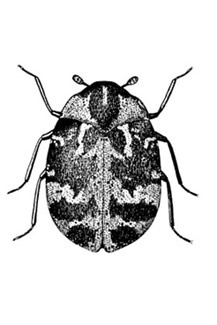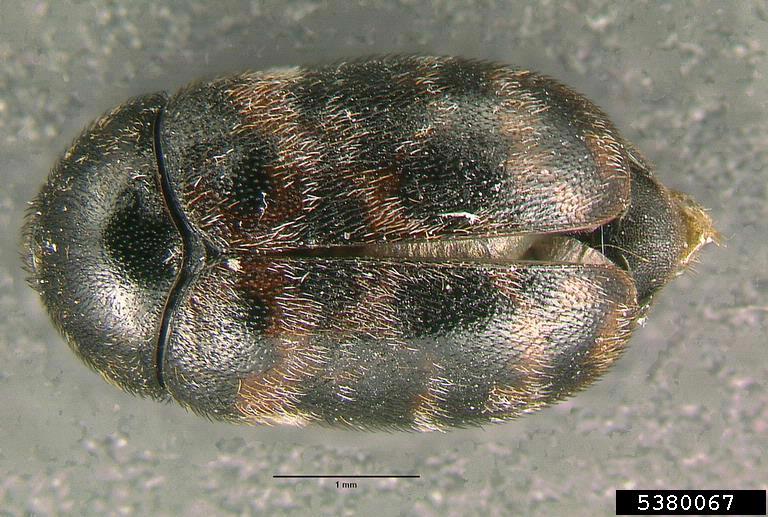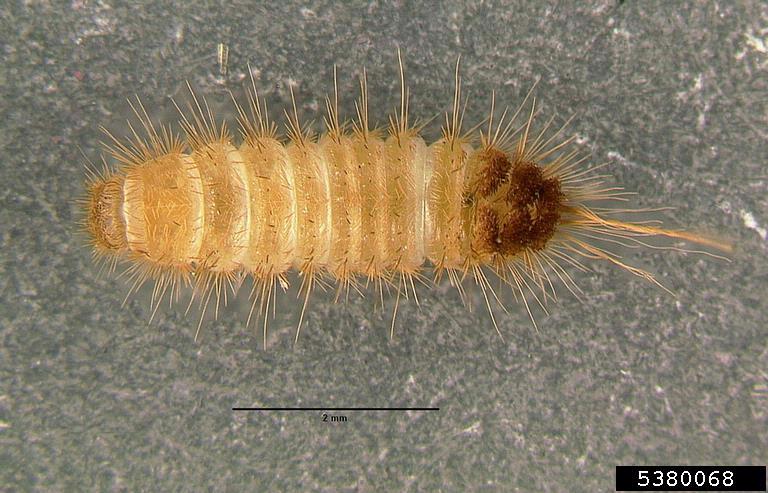 Watch for Carpet Beetles - March 27, 2019 Jeff Schalau, Agent, Agriculture & Natural Resources University of Arizona Cooperative Extension, Yavapai County Carpet beetles are pests in warehouses, homes, museums, and other locations where suitable food exists and can cause serious damage to fabrics, carpets, furs, stored foods, and preserved specimens. Carpet beetles belong to the family of beetles known as dermestids (also called skin beetles). Some species of these insects are used by mammologists used to clean animal skeletons in scientific collections. The specimens brought in to our offices for identification have often been collected from home storage spaces where there is little disturbance and stored materials contain fiber, feathers, fur, or other materials containing keratin. Three species of carpet beetles are known to be pests in Arizona. These are the varied carpet beetle, furniture carpet beetle, and the black carpet beetle. Adult varied and furniture carpet beetles are smaller (1/10” long) than the black carpet beetle adults (1/8-3/16” long). All three go through a larval stage and this life stage is when they are most destructive. The larvae of all three species are visibly hairy. For photos of carpet beetles, see the on-line version of this column. Outdoors, adult female beetles search out spider webs and nests of bees, wasps, and birds where they can lay eggs. These places contain dead insects, beeswax, pollen, feathers, or other debris that can serve as larval food. Indoors, carpet beetles deposit eggs on or near woolens, carpets and rugs, animal skins, furs, stuffed animals, leather book bindings, feathers, animal horns, whalebone, hair, silk, dried plant products, and other materials that serve as food for carpet beetle larvae. Damage from clothes moths vs. carpet beetles can be difficult to distinguish, but in general, the beetles are more likely to damage a large area on one portion of a garment or carpet while moth damage more often appears as scattered holes. Also, carpet beetle larvae leave brown, shell-like, bristly looking cast skins when they molt. These skins and the lack of webbing are usually good clues that you are looking at carpet beetle damage. Carpet beetles are among the most difficult indoor pests to manage because of their ability to find food in obscure places and to disperse widely throughout a building. Successful management depends on integrating the use of sanitation and exclusion, and, in some cases, insecticides. First, eliminate the obvious: accumulations of lint, hair, dead insects, and other debris that serve as food. Discard badly infested items. Remove bird, rodent, bee and wasp nests, and old spider webs, which may harbor infestations. Examine cut flowers for adult beetles (they feed on pollen and nectar). Regular and thorough cleaning of rugs, draperies, upholstered furniture, closets, and other locations where carpet beetles can congregate is an important preventive and control technique. Frequent, thorough vacuuming is an effective way of removing food sources as well as carpet beetle eggs, larvae, and adults. After vacuuming infested areas, dispose of the bag promptly because it may contain eggs, larvae, or adult insects. Infested items can be placed in a freezer for two weeks or heat-treat them at temperatures above 120 degrees F for 30 minutes. Some pest control companies also have heat chambers where infested items can be treated (heat is also a treatment that kills bed bugs). In cases where infested items cannot be dry-cleaned or laundered, they can be sprayed with an insecticide. Purchase a product that lists carpet beetles on its label and closely follow the directions. Apply insecticides as spot treatments and limit sprays to edges of floor coverings, under rugs and furniture, floors and walls of closets, shelving where susceptible fabrics are stored, cracks and crevices, and in other lint-accumulating areas. Be sure not to spray clothing and bedding. Pesticides can be used to protect non-food items in storage, first make sure they are pest-free and clean. Place them in an airtight container, using paper to make a layer every few inches. On the layers you can place insecticide-impregnated resin strips that are labeled for control of carpet beetles on fabrics. Some people also use moth balls, flakes, or crystals to control carpet beetles. Be sure to keep these materials out of reach of children and pets and follow label directions. Follow the Backyard Gardener on Twitter – use the link on the BYG website. If you have other gardening questions, call the Master Gardener help line in the Camp Verde office at 928-554-8992 or e-mail us at verdevalleymg@gmail.com and be sure to include your name, address and phone number. Find past Backyard Gardener columns or provide feedback at the Backyard Gardener web site: http://cals.arizona.edu/yavapai/anr/hort/byg/. Photos  Black carpet beetle damage to a wool sweater (Clemson University USDA Cooperative Extension Slide Series, Bugwood.org).
Black carpet beetle damage to a wool sweater (Clemson University USDA Cooperative Extension Slide Series, Bugwood.org). Carpet beetle adult (Megatoma variegata, Gary Alpert, Harvard University, Bugwood.org).
Carpet beetle adult (Megatoma variegata, Gary Alpert, Harvard University, Bugwood.org). Carpet beetle larva (Megatoma spp., Gary Alpert, Harvard University, Bugwood.org).
Carpet beetle larva (Megatoma spp., Gary Alpert, Harvard University, Bugwood.org).Additional Resources Carpet Beetles, Colorado State University Extension extension.colostate.edu/topic-areas/insects/carpet-beetles-5-549/ Carpet Beetle Management Guidleines, University of California Agriculture and Natural Resources ipm.ucanr.edu/PMG/PESTNOTES/pn7436.html |